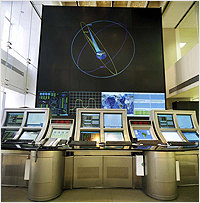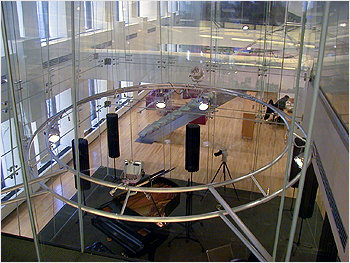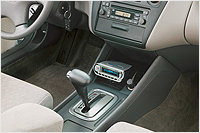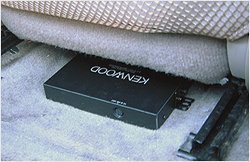 |
Site created 12/15/97.

page created: 2/4/04
Are You Sirius?
A Look at Satellite Radio
 |
|||
"Radio is the sound salvation..." Elvis Costello sang those very words some years back. And while the rest of the song is less than favorable toward the tight structure of radio today, it was becoming quite evident (even as early as the 80s) that Elvis recognized the power and draw of radio as a medium. Turning the dial to the present time, radio is an unrecognizable mess of signals and 3-hour play lists of only the biggest pop or corporate rock hits. Worse, it's become quite genre-specific, with an increasingly turbulent whirlwind of changing formats - one week you'll find an adult alternative station and the next, on the very same frequency, a talk radio station. There was a time where radio was the king of entertainment, with families huddled around large radio consoles listening to Mystery Theatre, The Green Hornet, The Lone Ranger, or their favorite variety, music and news shows. Many adults today grew up with the radio as their earpiece to the world. Television was fine and dandy, but could never hope to replace the steady stream of pleasing sounds and styles from a vast catalog of artists. TV also wasn't portable, which made radio that much more user friendly. The bottom line was that radio was positioned to be a primary medium of change and discovery. So what happened to that utopia of discovery? Time is what happened; time and a greater need by young people to define their identities in ever more specific ways. It's no longer sufficient to be content with a vast style of music - young listeners want to delve more deeply into their own genres and styles of music, from Grunge to Teen Pop, and Rap to Electronica. As a result, radio stations have struggled to create a specific location of retreat and identity for their listeners, usually by opting for a less diverse, more genre-centric style of programming. As radio evolved through the late 80s and 90s and into the present time, it became a more corporately controlled medium with ever smaller playlists and ever longer commercial breaks. Scan the radio dial today, and you might find a few stations to your liking... but not many. All that is changing, however, thanks to new technology. Enter the new era of subscription satellite radio, with hundreds of digital channels beamed by orbiting platforms to mobile receivers over vast geographic areas - even whole continents. Finding a favorite station is easy (you'll likely find many favorites on such a vast radio dial), and you'll never have to worry about losing the signal when you're driving to Grandma's house. Because of the large coverage area, you'll get the same stations in L.A. as you would in New York or Miami. Your favorite music is always there when you want it, with far greater variety of selection. Best of all, because it's a subscription service, the vast majority of the channels are 100% commercial free. That's the potential of satellite radio, and that's exactly what you get with Sirius. |
|||
|
|||
| Like
Rock and Roll? No problem - there are 16 different streams of it,
from different eras of Classic Rock to Hard Rock, '80s Hair Bands,
Metal, Alternative, Reggae, College Rock, Indie Music and on and on.
Want more from your Country music station? Sirius delivers 6
different streams, again broken into different time periods and
styles, such as Bluegrass and Folk. Into Jazz and Big Band music?
There's 6 different streams of that too. And that's just scratching
the surface. The thrill here isn't so much that of just more music, it's the immediate diversity you have access to that impresses. You can surf through the musical expanse of your life in mere pushes of pre-set buttons. The best thing is, more than 60 of these music streams are ENTIRELY commercial free, and the DJs aren't there to annoy you with inane banter. No more will you have to endure to Danny and Janie for the Morning Drive - it's all music, all the time. On the rare occasion the DJ does jump in, it's to tell you who sang the last song you just listened to. Or, he or she might update you on where your favorite artists are in concert, or when their next album comes out. And that's about it. Really, isn't that all you want to know from a good DJ? It recalls the nostalgic feel of radio of old, when the DJs were actually music experts and all they wanted to do is to expose you to more of it. Speaking of nostalgia, some of the classic channels even feature additional little touches to get you in touch with specific eras of music, like radio jingles from the 60s and 70s. Anyone else remember the old WLS or WFLD (Chicago) jingles? |
|||
|
|||
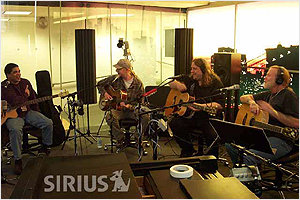  Recent performance studio visitors: The Allman Brothers Band (left) and Ben Harper (right) |
|||
Once you've exhausted all the music options, and you just can't sing or listen to another tune, Sirius gives you a lot of other choices as well. Herein lies the greater allure. How about listening to CNBC, CNN Headline News, Fox News, the BBC World Service or NPR? There's a comedy stream, separate left and right political talk streams, and Radio Disney for the kids. There's C-Span to keep track of Congressional happenings, and Bloomberg Radio for the financial wizard in you. Travelling by car? There are different regional Weather Channel streams to tell you the latest road conditions. There are also audio streams of such cable TV offerings as the Discovery Channel, The Word Network, CourtTV, Biography, and more. Note that it's these streams that aren't commercial free - whatever ads the individual networks are running are carried here too. Aside from the music, here's the thing we found most attractive... if you're a sports fan, Sirius has the best channel line-up you could ask for. Not only do you get multiple ESPN streams for general, all-around sports news, Sirius also carries nearly every NBA and NHL game on the schedule, regardless of where you live in the country. Wanna listen to the Celtics game but you live in Houston? No problem... and you'll even get to hear the home radio announcers calling the game. Sirius also carries Major League Baseball games on ESPN (with talk of more games covered in the future). Best of all, starting with the 2004-2005 season, you'll get to hear EVERY NFL football game, exclusively on Sirius (Sirius has a 7-year deal with the NFL, and also has exclusive rights to the NHL). And unlike satellite TV services like DirecTV, you don't have to pay extra for these games - it's all covered by your monthly subscription fee. You can bet we'll be listening to a lot of Bears and Vikings games next season. If we were to make suggestions for future programming offerings, we'd love to see streams for unsigned bands, for B-sides and rarities, for album sides, for covers only (for example, tracks like U2's cover of Lou Reed's Satellite of Love) or even all-ambient content. How about Ska, British Invasion and a greater diversity of World music? Really, the potential is limitless. Satellite radio could become THE hot place for new talent to be discovered, just like standard radio used to be in the 50s, 60s and 70s, and MTV was in the 80s and early 90s. Click here for an Adobe PDF file with detailed information on Sirius's current channel line-up. As we mentioned earlier, you can choose to pay the monthly fee of $12.95, or you select one year or two year plans. The one year plan currently runs $142.45 (and gives you one month free), while the two year plan costs $271.95 (and gives you three months free). If you're seriously committed, you can also pay a one-time, lifetime subscription fee of $499.99 (actually a good deal that would save you a lot of money after just a few years). The subscription plans, however, are where we have our major complaint with Sirius. It's not so much the cost, as the fact that the subscriptions only apply to a single receiver. That means if you have Sirius in your car, and later want to buy a Sirius-equipped boombox for example (they're coming starting in 2004), you'll have to pay a separate subscription fee for each new receiver (on the monthly plan, it's an additional $6.99 a month). If satellite radio ever takes off to the point that people really become addicted to it, consumers are going to want the ability to have multiple receivers... and they're not going to want to pay an extra subscription fee on top of the hardware costs. A single payment should cover all the devices you own in our opinion. Of course, given that satellite radio is still so new, companies like Sirius are still trying to recoup their up-front costs. We would expect more and better subscription options in the future. An additional problem with these plans is the speed of technology development. With cooler and more efficient Sirius-ready equipment being manufactured all the time, your existing receiver will become obsolete over time, and you might want to upgrade. Now if only we could transfer that lifetime subscription plan over to each new receiver, the deal would definitely be worth it. Speaking of new Sirius-ready equipment, the satellite service has partnered with a number of electronics manufacturers in the effort to bring a whole range of new consumer devices to market. These include Kenwood, U.S. Electronics, Crestron, Niles, Blaupunkt, Pana-Pacific and Audiovox. Portable units like the aforementioned boomboxes are on the way, as are small, Walkman-style portables. In other developments, Sirius has adopted the Dolby Pro Logic II standard to bring multi-channel audio to some of its streams in the future. In conjunction with Antex Electronics, Sirius has developed a special multi-zone, multi-room receiver for the home, which means that with one receiver, people in different rooms can be listening to different streams. Sirius has also teamed up with Delphi to eventually deliver multiple channels of live, in-car video programming in addition to its audio streams. |
|||
|
|||
| Once
you have your unit installed, you need to call Sirius' toll free
number to activate it (there's a $15 activation charge if you do
this by phone - you pay only $5 if you activate your unit online).
Each receiver has its own ID/ESN code number. Once you've arranged
billing and selected a service plan, you simply give the operator
your unit's code number and they send out an activation signal (via
satellite) to turn on your receiver (it usually takes between 30
seconds and 5 minutes). Voila... you're up and running. The Kenwood Here²Anywhere unit includes a remote that lets you scan the streams easily (you can also do so with buttons on its face). You have the ability to scan other streams visually, without interrupting the one that's currently playing. Better still, you can see not only the names and numbers of the other streams, but also the specific artist and song that's currently playing on each. The Here²Anywhere can remember 24 artist/song title sets in its memory (for example, if you hear a song that you like and wish to remember later), and you can also program 24 stream presets for quick access. When searching for a stream that may interest you, you can choose from a menu that describes the stream's format by use of certain naming conventions (for example: Alt Nation, First Wave, The Pulse, Jam Central, and so on). You can also change streams on the fly by selecting them with your remote (by moving to the next or last in the list, or by jumping right to the stream you want by entering its specific number). If you're on the go, home installation isn't the only option with the Kenwood Here²Anywhere. Just unsnap the unit from your home docking station, tuck it into its carrying pouch, and take it on the road with you in your car. The unit also snaps into a special auto docking station that's available (it can be mounted to your dash, or elsewhere in your vehicle). A small antenna is mounted on your roof (it's held securely in place magnetically), and you just run the wire out of the way (under the carpet for example) into the back of your unit. In theory, you could also mount the antenna on your dash or in a window space - anywhere you get direct line-of-site to the sky. Installation is fairly easy to do yourself, or you can get it done by a qualified professional installer. A standard cassette adaptor can then be used to run the sound through your car's existing tape player so you can hear the sound through your existing speakers. We've put the auto option through its paces, and we can report that it works very well. In fact, when we drove to CES in January, we took the Here²Anywhere with us. Rather than bothering to install the unit, we simply set the antenna in the back window. Reception was near perfect for the entire 4-hour trip to Las Vegas, even when passing through the mountains or the middle of Death Valley. In fact, the only time reception really wavers in your car is when you pass through a tunnel or under the occasional freeway overpass, which is to be expected given the satellite's line-of-site transmission format. But once you're back out in the open again, the signal is immediately reacquired (we never lost the signal for more than a second or two at a time during the CES trip, and then on only a handful of occasions). Bill was actually so pleased with the Sirius service after trying the Here²Anywhere unit, that he decided to purchase a fully-featured headunit from Kenwood for his car. The KDC-MP222 incorporates a standard AM/FM tuner and CD player as well as Sirius capability. The headunit installs in-dash just as you'd expect. The only difference from a standard mobile installation is that the Sirius option requires an additional satellite tuner to be placed somewhere out of the way in the vehicle (in Bill's case under the front passenger seat), along with the small satellite antenna that's mounted on the roof. |
|||
|
|||
What Sirius aspires to become is an 'on the move' service for digital entertainment. Whether you're in your car, at your desk, on the treadmill exercising, or just out for a leisurely walk, it enables you to listen to a greater variety of your favorite music anywhere. No commercials during the music, no extended DJ jabber, no 20-song play lists, dozens of streams of music, news, talk, sports and more - these are all very attractive features to those of us who remember a day when radio actually tried to serve its audience as much as the music industry. Satellite radio technology is still relatively new, and has yet to catch on widely with consumers, but it has a lot of potential. It's important for us to note that Sirius is only one provider of the service (there are others, like XM, that we haven't yet tried). That said, it only took a day or two of trying Sirius before we were addicted. We can tell you from first-hand experience that satellite radio makes the very idea of radio fun again. If you love music, and don't mind the idea of a subscription fee, it's definitely worth a look. For more information, be sure to visit the Sirius website. Matt Rowe mattrowe@musictap.net Bill Hunt billhunt@thedigitalbits.com |
|||
 |
| Site
designed for 800 x 600 resolution, using 16M colors and .gif 89a
animation. © 1997-2015 The Digital Bits, Inc., All Rights Reserved. billhunt@thedigitalbits.com |
